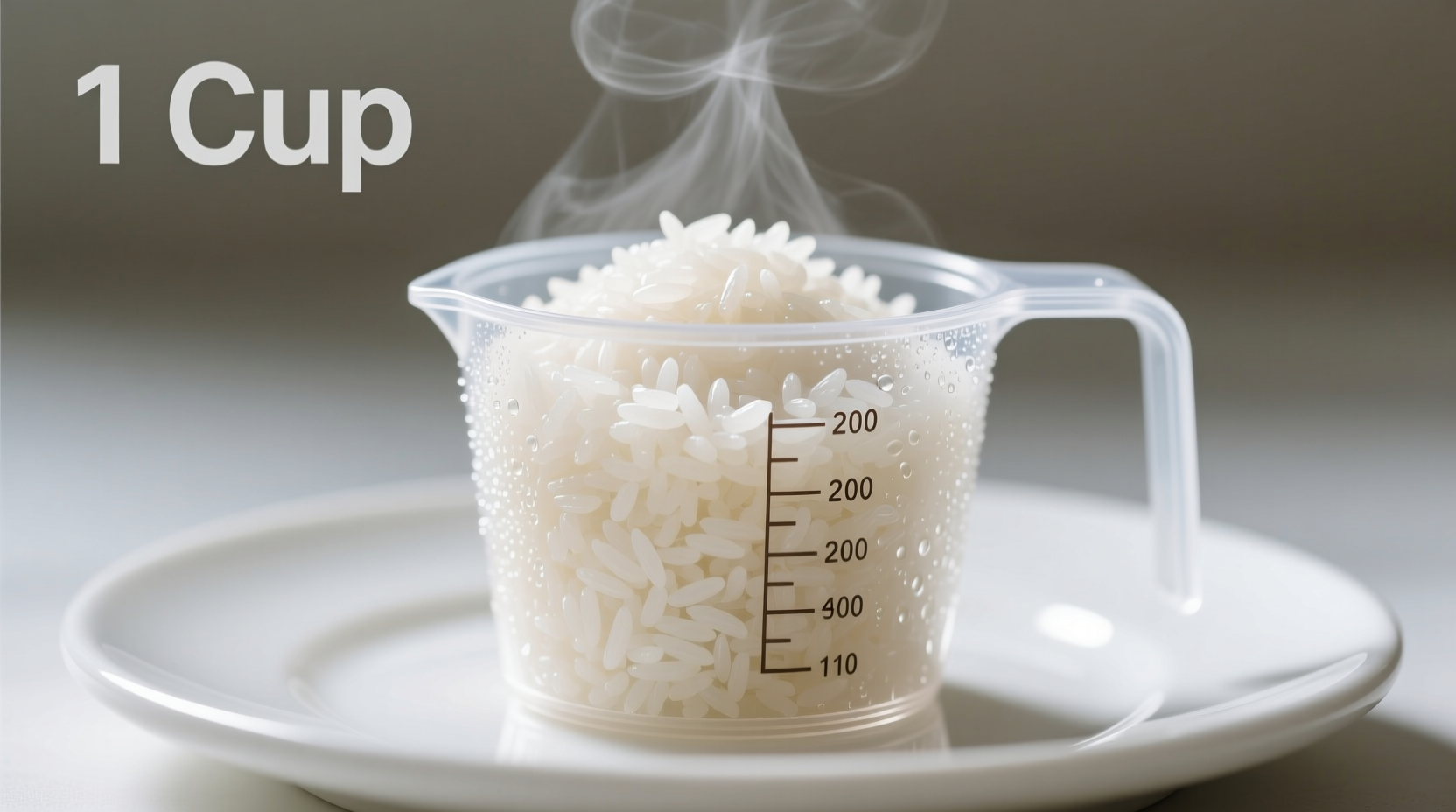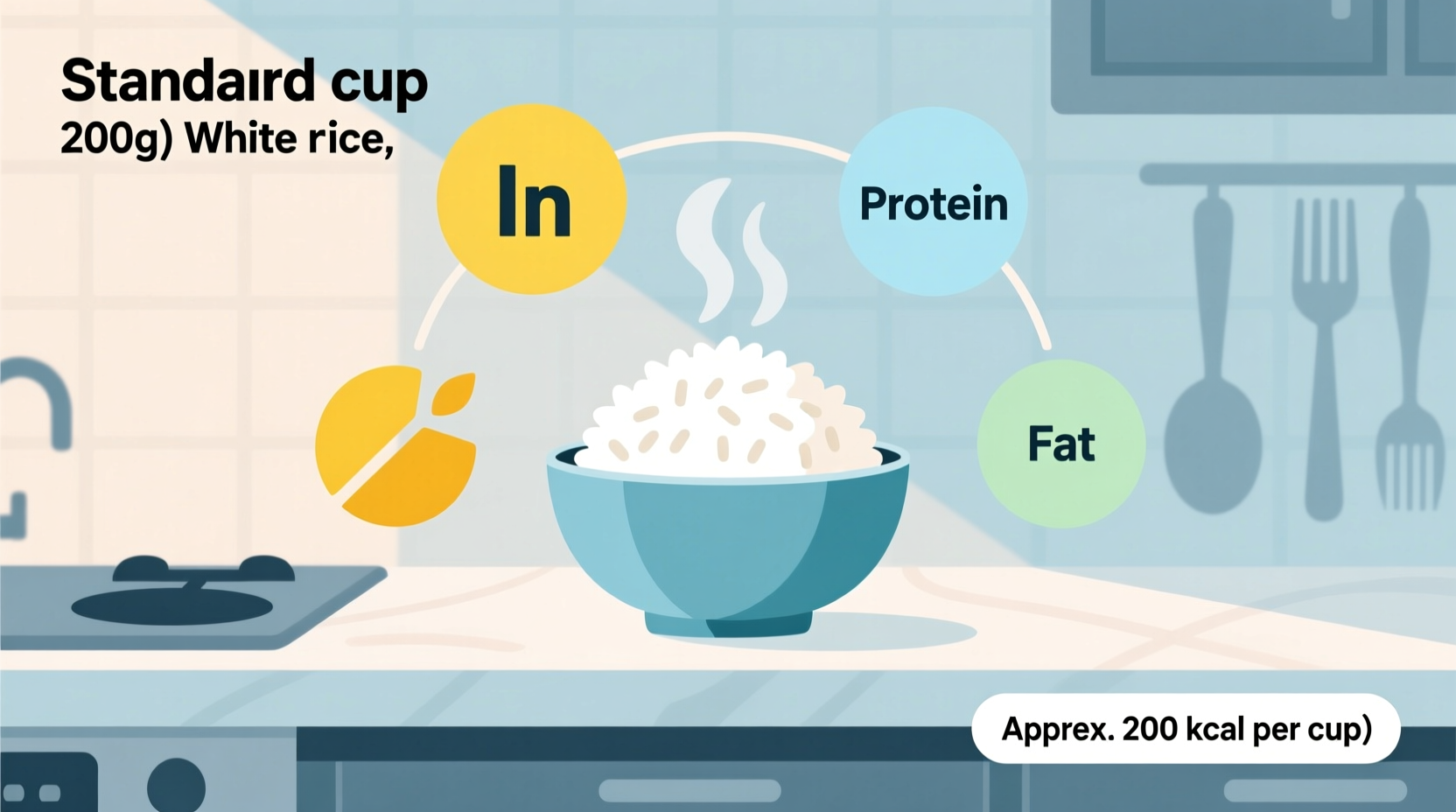Understanding the exact calorie content of your daily staples is crucial for effective meal planning and nutrition management. Whether you're tracking macros, managing weight, or simply curious about your food, knowing the precise nutritional value of cooked white rice helps you make informed dietary decisions without guesswork.
Exact Calorie Count and Portion Size Considerations
When discussing "a cup" of cooked white rice, precision matters. The standard measurement used by nutrition professionals and the USDA is 1 cup cooked (158 grams), which contains 205 calories. However, portion sizes can vary significantly based on how the rice is packed:
- Loosely packed: Approximately 180 calories per cup
- Standard serving (158g): 205 calories
- Firmly packed: Up to 230 calories per cup
This variation explains why many people unknowingly consume more calories than expected. The USDA's FoodData Central database, maintained by the Agricultural Research Service, provides the most reliable nutrition information for American consumers.
| Rice Type | Calories (per 1 cup cooked) | Carbohydrates | Protein |
|---|---|---|---|
| White rice (long-grain) | 205 | 45g | 4.3g |
| Brown rice (long-grain) | 218 | 46g | 5.5g |
| Basmati rice (white) | 210 | 45g | 4.2g |
| Jasmine rice (white) | 205 | 45g | 4.2g |
Nutritional Composition Beyond Calories
While calories are important, understanding the complete nutritional profile helps you evaluate how white rice fits into a balanced diet. One cup of cooked white rice provides:
- Carbohydrates: 45 grams (15% of daily value)
- Protein: 4.3 grams
- Fat: 0.4 grams (virtually fat-free)
- Fiber: 0.6 grams (significantly less than brown rice)
- Manganese: 19% of daily value (important for metabolism)
- Selenium: 14% of daily value (supports thyroid function)
White rice undergoes milling that removes the bran and germ, resulting in lower fiber and nutrient content compared to brown rice. However, many brands fortify white rice with B vitamins like folate, which is particularly important for pregnant women. The American Journal of Clinical Nutrition published research showing that fortified white rice can help address nutrient deficiencies in populations where rice is a dietary staple.
Practical Applications for Your Diet
Knowing the calorie content is just the beginning. Here's how to use this information effectively:
Meal Planning Strategies
For most adults following a 2,000-calorie diet, a standard cup of cooked white rice represents about 10% of daily calorie needs. Registered dietitians often recommend:
- Weight management: Measure portions before cooking (¼ cup dry rice yields ~1 cup cooked)
- Balanced meals: Pair ½ cup rice (102 calories) with 3-4 oz protein and 2 cups vegetables
- Post-workout: Combine rice with lean protein for optimal recovery
Common Preparation Variables
The cooking method affects calorie density. Rice cooked with broth instead of water adds minimal calories (about 10 per cup of broth), while adding butter or oil significantly increases calorie content:
- 1 teaspoon butter: +34 calories
- 1 tablespoon olive oil: +120 calories
- Rice cooked in coconut milk: +100-150 additional calories

White Rice in Global Dietary Guidelines
Nutrition recommendations for rice consumption vary by region based on dietary patterns. The Dietary Guidelines for Americans suggest making half your grains whole grains, but acknowledge that enriched white rice provides valuable nutrients. In contrast, Asian dietary guidelines often feature rice as a primary carbohydrate source with recommended portions of 1-2 cups per meal.
Research published in the British Medical Journal analyzed rice consumption patterns across 21 countries and found that moderate white rice consumption (1-2 cups daily) as part of a balanced diet doesn't negatively impact metabolic health for most people. The key factor was what accompanied the rice in meals - diets high in vegetables and lean proteins showed better health outcomes than those with rice paired with fried foods and sugary sauces.
When White Rice Fits Your Nutrition Goals
White rice serves specific purposes in various dietary approaches:
- Athletes: Provides easily digestible carbohydrates for energy replenishment
- Digestive issues: Often recommended during gastrointestinal recovery due to low fiber
- Meal prep: Maintains texture and flavor when reheated better than some whole grains
- Cultural diets: Integral to balanced traditional eating patterns across Asia and Latin America
For those concerned about blood sugar impact, pairing white rice with vinegar (as in sushi rice) or cooling and reheating rice can increase resistant starch content by up to 30%, according to studies from the Journal of Nutrition and Food Sciences. This simple technique reduces the glycemic impact while maintaining the familiar texture of white rice.
Frequently Asked Questions
Here are answers to common questions about white rice nutrition:
- Does the brand of rice affect calorie count? Most standard long-grain white rice varieties have nearly identical nutritional profiles when cooked using the same water-to-rice ratio.
- How do I measure cooked rice accurately? Use a dry measuring cup and level off the top without packing for standard nutritional calculations.
- Is day-old rice lower in calories? Cooling and reheating increases resistant starch, which provides fewer metabolizable calories, but the difference is minimal for typical portions.
- How does rice compare to other carbohydrates? Per 100g, white rice has similar calories to pasta (158 vs 157) but fewer than cooked quinoa (120).











 浙公网安备
33010002000092号
浙公网安备
33010002000092号 浙B2-20120091-4
浙B2-20120091-4